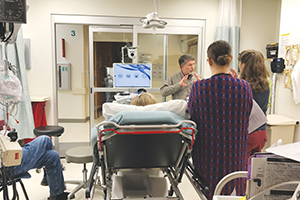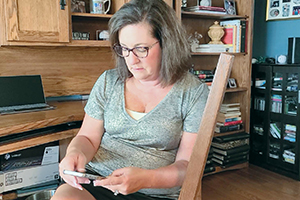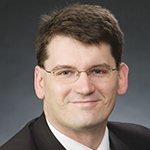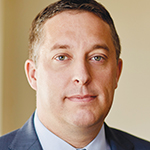By LISA EISENHAUER
The COVID-19 pandemic has been the catalyst for an explosion in telehealth and physicians who oversee aspects of virtual care at three Catholic health systems say the platform has proven its value across specialties. They fully expect its popularity to
endure after the health emergency ends.

Fenton
"I think the patient adoption of it, the changing demographics of patients, the technology is really setting the tone to make this basically a permanent fixture in health care," said Dr. Carter Fenton of Mercy. He directs a virtual acute care program
for the four-state system based in suburban St. Louis. Mercy has been building its virtual medicine capacity for about 15 years.
A report from the U.S. Department of Health and Human Services in December stated that the number of Medicare visits conducted through telehealth increased from about 840,000 in 2019 to 52.7 million in 2020.
The nonprofit FAIR Health, which tracks private health insurance claims, reported that telehealth went from 0.15% of claims in April 2019 to 13% in April 2020.

Tim Lorimer, a telehealth clinical program manager, trains a group of workers at South Peninsula Hospital in Homer, Alaska, on delivering virtual care. Providence St. Joseph Health worked with the hospital to provide telehealth services for its patients.
The use of telehealth technology has surged since the start of the COVID-19 pandemic and its popularity is expected to remain high.
The growth spike was driven by pandemic exigencies. There were strict safety protocols in place early in the COVID-19 outbreak that limited in-person medical care including for the chronically and acutely ill. Federal regulators relaxed restrictions for
Medicare-paid telehealth visits in March 2020. The waiver extends until the end of the public health emergency. Federal officials encouraged states and private insurers to provide similar flexibility for telehealth coverage, and many of them did.
Receptive market
Physicians at Catholic systems said the embrace of remote care continued to grow after restrictions began to ease on nonemergency appointments and procedures in the late spring of 2020.
COVID Care @ Home, started in 2020 by Mercy, had enrolled 70,000 outpatients across the multistate
system by early 2022 and is the source of about 600 telehealth visits a day. The program gives patients around-the-clock access for 14 days to emergency medicine physicians via texts and audio and video calls to ask questions and get consults on their
symptoms.
The program is part of Mercy Virtual's vAcute, which is led by Fenton. "We're able to provide real time care and set real expectations for what we think needs to
be done to get the patients the most appropriate care," he said.
In Fenton's view, vAcute is a complement to Mercy's primary care services. Primary care doctors are notified of patients' vAcute visits and take over follow-up treatment. "We actually are driving, hopefully, much more appropriate utilization of inpatient
and in-person care," he said.

Christine Storm, who contracted COVID-19 early this year, uses her smartphone to connect with providers through Mercy's COVID Care @ Home. The telehealth program that the health system started in 2020 gives patients 24/7 access to a team of emergency
medicine physicians who monitor patients' well-being via daily texts, video consults and phone calls.
The vAcute program is just one part of Mercy's telehealth care operation, which began well before the pandemic and has seen astronomical gains in popularity since. In 2019 Mercy tallied 10,000 virtual visits. Since the start of the pandemic in 2020 through
mid-January, that count rose to 800,000.
Mercy recently got a $2.2 million federal grant to add and upgrade telemedicine carts and monitors at facilities in Missouri, Oklahoma and Arkansas so that staff, especially those in the system's COVID and critical care units, can teleconference with
off-site specialty caregivers. The grant was part of more than $458 million that has been appropriated nationwide so far
by the Federal Communications Commission to help health care providers deliver connected care services to patients at their homes or mobile locations in response to the COVID-19 pandemic.
Sudden growth, lasting embrace
Providence St. Joseph Health, which operates in five western states, also reports skyrocketing use of telehealth services. In 2019, the system recorded 70,000 telehealth visits; in April 2020, when in-person
nonemergency medical services were curtailed, it had that number of telehealth visits every week.

Czartoski
"We're still doing about 100,000 visits a month," Dr. Todd Czartoski, chief medical technology officer at Providence, said in mid-February. "It's roughly just under 20% of our clinic visits."
Czartoski said while Providence patients and providers are not required to use telehealth, the platform has gained favor on both sides. One specialty where telehealth use has been particularly high, he said, is behavioral health, with about 50% of visits
now virtual.
Czartoski is a neurologist and he spent a decade evangelizing for the use of telehealth after he saw the effectiveness of a network he helped develop to care for stroke patients. "It was a lot like rolling a boulder uphill," he recalled of his advocacy
efforts, with many colleagues not just uninterested but convinced that telehealth was not a legitimate way to practice medicine.
That changed when the pandemic hit and clinics temporarily closed, cutting doctors off from their patients. "Many of the same doctors who were lecturing me on how this wasn't real medicine were instantly now demanding that they have access to all these
different tools so they can do telehealth," he said.
Because Providence had been ramping up its telehealth services for years, Czartoski said the system was able to expand those services fairly quickly to all of its 15,000 care providers. In one week in March 2020, it brought 7,000 of them online.
Technology plus resources
While not all patient needs can be addressed by a remote provider, Czartoski said a great many can. In addition to technology to do audio or video evaluations, Providence providers have access to resources
to help them direct patients to the nearest labs for testing or facilities for X-rays if those services are needed. The results go into patients' electronic medical records where providers can access them.
The system's video visit technology also has embedded interpreter services so that providers and patients can communicate even if they don't speak the same language.
Czartoski said Providence looked into how many patients came into a clinic or hospital for in-person care within 72 hours of a telehealth visit and found it was "well under 1%."
"Our experience tells me that it is effective and it's not additive; you're not doing both a virtual visit and then an in-person visit," he said. "If done properly, a virtual visit can replace an in-person visit."
Widespread use
People in rural and urban areas and across socioeconomic categories such as age, gender, race and income are opting for televisits, Czartoski said, rather than coming to emergency rooms and clinics. "The convenience
factor in access is huge," he said.
An issue brief from the Department of Health and Human Services in February similarly noted
widespread use of telehealth. It cites surveys consistently showing that about one-fourth of Americans have had a telehealth visit in any given four weeks. The figure tends to be higher for some populations, such as those who are Medicaid or Medicare
beneficiaries, and lower for some, such as those who are uninsured.
The surveys showed significant disparities in terms of audio versus video telehealth use, with those who have lower household incomes being more likely to have audio rather than video telehealth visits. One of the issue brief's conclusions is: "Investments
in Internet access, video-enabled devices, and culturally competent care are needed to ensure equitable use of telehealth services."

Testa
At CommonSpirit Health, Dr. Nicholas Testa is the chief physician executive for California. He said that while limited access to technology is probably a barrier to aspects of telehealth for some patients, anyone with a phone can get access to quality
remote care through his system. "It's been a really strong tool through the pandemic," Testa said.
He pointed to CommonSpirit Health's Dignity Health St. Mary Medical Center CARE Center in Long Beach, California, which serves the LGBTQ community and is part of his division. The CARE Center ramped up its behavioral telehealth outreach programs early
in the pandemic as virus-related concerns limited in-person interactions.
The demand for virtual therapy from the CARE Center spiked and it has stayed high. "I really think it tells the story of the fact that telehealth has opened a door to better care," Testa said.
No letup in sight
He said that across the 21 states that CommonSpirit serves, the system has accommodated more than 2 million telehealth visits since the start of the pandemic.
Testa said CommonSpirit has found patients are much more likely to keep appointments for follow-up care if they can do them by phone. "There's a lot fewer no-shows," he said. He suspects that is because patients don't have to worry about issues like transportation
and child care that can be hurdles to getting to in-person appointments.
Testa is confident virtual visits aren't a fleeting fad. "I don't foresee them going away," he said. "I think patients like them. I think providers like them. I think it's in the best interest of care."
CHA, Ascension urge Congress to support permanent telehealth expansion
In response to the global COVID-19 pandemic and as part of the public health emergency, federal regulators in March 2020 put in place a number of waivers and revised reimbursement policies to allow greater access to telehealth services. The waivers
only extend for the duration of the declared public health emergency.
Many health care providers and advocacy groups are pushing for the waivers to be extended to provide time for the development of thoughtful public policy governing telemedicine.
CHA was among dozens of health-related organizations that in January sent a letter to congressional leaders urging that they establish a pathway for comprehensive telehealth oversight that allows the public to reap the benefits of the technology. The letter says access to virtual care has been transformational and "Americans now expect that the
future of our health care system includes telehealth as a key way to access health care services."
The signatories ask Congress to continue through 2024 the waivers that lifted geographic and originating site restrictions (meaning patients had to be seen in a clinical space) for Medicare-reimbursed telehealth. They say that extension will provide
time to evaluate the impact the wider use of virtual care has had and time to use that research to craft policy.
The letter urges Congress to pass "permanent, evidence-based" telehealth legislation in 2024.

Swanepoel
Lucas Swanepoel, a CHA director of government relations, said there is reason to be hopeful that telehealth legislation will pass. Lawmakers in both chambers and on both sides of the aisle have submitted dozens of bills to address various aspects
of telehealth, Swanepoel said.
"What we're seeing now, because we're getting more studies and more research and of course we're getting closer to potentially the end of the public health emergency, is more effort to coalesce the very small ideas into one more all-encompassing
approach to address the extension of telehealth waivers," he said.
In both chambers there is bipartisan support for that effort, he noted, a key to passage of any legislation in a Congress strongly divided along political lines.
Many Catholic health systems, including St. Louis-based Ascension, are advocating for telehealth legislation, too. Dr. Baligh Yehia, president of Ascension Medical Group, called congressional action crucial for patients who have come to rely on
telehealth.
"Telehealth is improving access to care by lowering barriers for the underserved and those in rural areas who face challenges getting the care they need," Yehia said. "It's also helping lower health care costs by offering immediate access to care
that would have otherwise resulted in an emergency department or urgent care visit."
In addition to providing patients continued access to telehealth, Yehia said Ascension is urging Congress to address licensing-related issues that can prevent telehealth practitioners from providing care across state boundaries. At a minimum,
the system wants Congress to pass a pending measure that would grant temporary licensure reciprocity during public health emergencies.
— LISA EISENHAUER